
Elisabeth of Bavaria-Landshut (1383 – 13 November 1442), nicknamed "Beautiful Beth", was an Electress of Brandenburg.
Elizabeth was a daughter of Duke Frederick "the Wise" of Bavaria-Landshut and his second wife Maddalena Visconti. On 18 September 1401 she married Frederick VI of Hohenzollern, Burgrave of Nuremberg, who was promoted to Elector of Brandenburg in 1415 and ruled as "Elector Frederick I". During her husband's long journeys to Italy, Hungary, and to the Council of Constance, she represented him wisely despite the great political problems Brandenburg was experiencing at the time.
She is the ancestress of the royal line of the House of Hohenzollern by her third son Albert III Achilles, Elector of Brandenburg.

Frederick II (Friedrich, der Sanftmütige; Frederick the Gentle) (Leipzig, 22 August 1412 – 7 September 1464 in Leipzig) was Elector of Saxony (1428–1464) and was Landgrave of Thuringia (1440–1445).
Frederick was the eldest of the seven children of Frederick I, Elector of Saxony, and Catherine of Brunswick and Lunenburg.

Margaret of Austria (c. 1416 – 12 February 1486) was the elder daughter of Ernest, Duke of Austria and his second wife Cymburgis of Masovia. From her marriage she was Electress of Saxony. She was sister of Frederick III, Holy Roman Emperor.

William (German: Wilhelm) KG (c. 1392 – 1482), called the Victorious, was duke of Brunswick-Lüneburg. He is counted either asWilliam III or William IV.
William was the eldest son of Henry the Mild, Duke of Brunswick-Lüneburg. He inherited Lüneburg-Celle in 1416 and swapped it with his uncle Bernard I, Duke of Brunswick-Lüneburg, for Wolfenbüttel in 1428. While on a campaign in 1432, William was deposed by his brother Henry. William retained only the western part of Wolfenbüttel (to the west of the River Leine and separated from the rest by the Bishopric of Hildesheim), which was to become known as the Principality of Calenberg. After Henry died without son in 1473, William had control of both parts of Wolfenbüttel again.
Cecilia of Brandenburg (c. 1405 – 4 January 1449) was a princess of Brandenburg by birth and by marriage a Duchess ofBrunswick-Wolfenbüttel.
Cecilia was the daughter of Elector Frederick I of Brandenburg (1371–1440) from his marriage to Elizabeth (1383–1442), daughter of Duke Frederick of Bavaria-Landshut. Cecilia's brothers were the reigning Electors of Brandenburg, first Frederick II and later Albrecht III Achilles.
Count Bodo VII of Stolberg and Wernigerode (also known as Bodo the Elder; born: 1375; died: 15 March 1455 in Stolberg) was a German nobleman. He ruled the counties of Stolberg in the southern Harz and Wernigerode in the northern Harz.
Bodo was the son of Count Henry of Stolberg and Elizabeth née Countess of Hohenstein. Nothing is known about his youth. Perhaps he spent some time at a court of the Counts of Schwarzburg, possibly the one in the Sondershausen.
Anna, the daughter of Count Henry of Schwarzburg
Ulrich I of East Frisia, first count of East Frisia, (Norden, 1408 – Emden, 25 or 26 September 1466) was a son of the chieftain Enno Edzardisna of Norden and Greetsiel, and Gela of Manslagt.
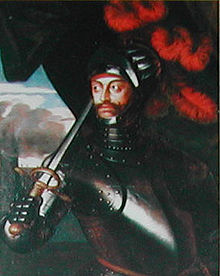
Theda Ukena (1432 in Oldersum – 16 November 1494 in Greetsiel) was from 1466 to about 1480 regent of the County of East Frisia.
Theda was the granddaughter and heiress of the chief Focko Ukena (died 1436) and was born in 1432 in Oldersum as the daughter of Uko Fockena and Heba Attena of Dornum. She was probably named after her grandmother Theda of Reide, the first wife of Focko Ukena. Her father was assassinated in June 1432.

Count John I of Rietberg (c. 1450 – 1516) was Count of Rietberg from 1472 until his death. He was the eldest son of CountConrad V and his wife Jacoba of Neuenahr.
Gerhard VI "the Quarrelsome", Count of Oldenburg (German: Gerhard (Gerd) der Mutige von Oldenburg; 1430 – 22 February 1500) was a Count of Oldenburg and regent of Bad Zwischenahn in 1440–1482.
Gerhard was the third son of Dietrich of Oldenburg and his wife, Helvig of Schauenburg. His eldest brother succeeded their father as Christian VI but was elected King Christian I of Denmark in 1448, therefore passing on the county to his brothers in 1450. In 1440–1463 Gerhard VI ruled in Delmenhorst as regent and in 1464–1482 (after the death of his brother Maurice) as the guardian of his nephew Jakob. He was constantly at war with Gerhard III, Prince-Archbishop of Bremen, and Frisians. In 1483 Gerhard was compelled to abdicate in favor of his sons, and he died whilst on a pilgrimage in the Rhône valley.
John V of Saxe-Lauenburg (also numbered John IV;[1] 18 July 1439 – 15 August 1507) was the eldest son of Duke Bernard II of Saxe-Lauenburg and Adelheid of Pomerania-Stolp (*1410 – after 1445*), daughter of Duke Bogislaus VIII of Pomerania-Stolp. He succeeded his father in 1463 as duke of Saxe-Lauenburg.
Dorothea of Brandenburg (1446 – March 1519) was a princess of Brandenburg by birth and by marriage Duchess of Saxe-Lauenburg.
Dorothea was the eldest child of Elector Frederick II of Brandenburg (1413–1471) from his marriage to Catherine (1421–1476 ), daughter of Elector Frederick I of Saxony.
Henry (Latin Henricus; 14 June 1463 – 23 June 1514, Leer), Duke of Brunswick-Lüneburg, called Henry the Elder or Henry the Evil, was prince of Wolfenbüttel from 1491 until his death.
Henry's father, William IV, Duke of Brunswick-Lüneburg, retired in 1491, leaving government of Wolfenbüttel to his two sons, Henry the Elder, and Eric. In 1494, the brothers divided the territory between them, and Henry received the eastern part of the state, with the cities of Brunswick and Wolfenbüttel.
Catherine of Pomerania-Wolgast (German: Katherine von Pommern-Wolgast) (c. 1465–1526) was the wife of Henry IV, Duke of Brunswick-Lüneburg, Prince of Wolfenbüttel. She was the daughter of Eric II, Duke of Pomerania-Wolgast, and Sophia of Pomerania-Stolp.
Derrick or Dietrich of Oldenburg, Latin-based Anglicisation also Theoderic of Oldenburg [1] (c. 1398 – 14 February 1440), nicknamed Theoderic the Lucky or the Fortunate (Teudericus Fortunatus), was a feudal lord in Northern Germany, holding the counties of Delmenhorst and Oldenburg. He was called "Fortunatus" as he was able to secure Delmenhorst for his branch of the Oldenburgs.
Dietrich was the father of Christian I of Denmark, a male-line ancestor to the present-day Danish throne under Margarethe II of Denmark as well as the last Czar of imperial Russia, Nicolas II. He is also the male line ancestor of Charles, Prince of Wales andHarald V of Norway.
Dietrich of Oldenburg was the son of Christian V of Oldenburg (who became count in about 1398 and died in 1423) and his wife, Countess Agnes of Honstein (c. 1410–1460). His grandfather, Conrad I of Oldenburg (d. ca. 1368) had left his lands divided between Dietrich's father and uncle, Conrad II.

Helvig of Schauenburg (German: Heilwig von Holstein) (1398–1436), also known as Hedwig of Schauenburg,[citation needed] was a duchess of Schleswig and a countess of Holstein from the family of Schauenburg, and ancestor of the Danish Royal houses ofOldenburg and Schleswig-Holstein-Sonderburg-Glücksburg.
She was a daughter of Gerhard VI of Holstein-Rendsburg and his wife, Catherine Elisabeth of Brunswick-Lüneburg. Her brother wasAdolf VIII/I, Count of Holstein/Duke of Schleswig. Through their father, they were cognatic descendants of King Eric V of Denmarkwhile through their mother, they were cognatic descendants of King Abel of Denmark.

Otto VII of Tecklenburg (died 1450) was Count of Tecklenburg from 1426 until his death.
Otto VII was the son of the only son of Count Nicholas II of Tecklenburg and his wife Anna Elisabeth, a daughter of Count Frederick III of Moers. In 1426, he succeeded his father as Count of Tecklenburg. Like his father, he fought many feuds, in an attempt to win back some of the territories his father had lost. The attempt failed, and pushed his county deeper into debt. This accelerated the decline of the county.
Magnus I, Duke of Mecklenburg (1345 – 1 September 1384) was Duke of Mecklenburg from 1383 until his death. Magnus was the third son of Duke Albert II of Mecklenburg and his wife Euphemia of Sweden, the sister of the King Magnus IV of Sweden.
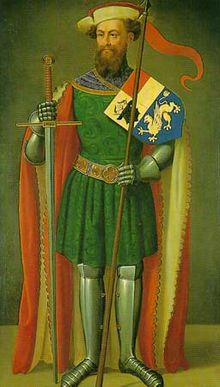
Elizabeth of Pomerania-Wolgast, daughter of Barnim IV, Duke of Pomerania.
Eric IV of Saxe-Lauenburg (1354 – 21 June 1411 or 1412) was a son of Eric II, Duke of Saxe-Lauenburg and Agnes of Holstein.
d Sophia of Brunswick-Lüneburg (1358–28 May 1416), daughter of Magnus II, Duke of Brunswick-Lüneburg


Eric IV of Saxe-Lauenburg (1354 – 21 June 1411 or 1412) was a son of Eric II, Duke of Saxe-Lauenburg and Agnes of Holstein.
d Sophia of Brunswick-Lüneburg (1358–28 May 1416), daughter of Magnus II, Duke of Brunswick-Lüneburg
Frederick V of Nuremberg (before 3 March 1333 – 21 January 1398) was a Burgrave (Burggraf) of Nuremberg, of the House of Hohenzollern.
He was the elder son of John II of Nuremberg and Elisabeth of Henneberg. From the death of his father in 1357, Frederick bore the title of Burgrave and so was responsible for the protection of the strategically significant imperial castle of Nuremberg. His zeal in the imperial cause led Charles IV to elevate him in 1363 to be the first Burgrave of royal rank.
Elisabeth of Meissen, Burgravine of Nuremberg (22 November 1329 – 21 April 1375) was the daughter of Frederick II, Margrave of Meissen and Mathilde of Bavaria and a member of the House of Wettin.
Frederick (1339 – 4 December 1393) was Duke of Bavaria from 1375. He was the second son of Stephen II and Elizabeth of Sicily.
Maddalena Visconti (1366 – 17 July 1404) was a daughter of Bernabò Visconti and his wife Beatrice Regina della Scala. Maddalena was Duchess of Bavaria-Landshut by her marriage to Frederick, Duke of Bavaria.
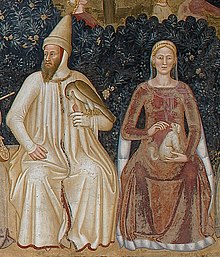
Barnim VI, Duke of Pomerania (c. 1365 – 22 September 1405 in Pütnitz, near Ribnitz-Damgarten) was duke of Pomerania-Wolgast from 1394 to 1405. He was the son of Wartislaw VI of Pomerania-Wolgast.

Bogislaw VIII (c. 1364 – 11 February 1418)[1] was Duke of Pomerania in Pomerania-Stolp from 1395 until 1418. Bogislaw V, Duke of Pomerania y Adelheid of Brunswick-Grubenhagen
Sophie of Holstein, the daughter of Henry II, Count of Holstein-Rendsburg.
Frederick (1339 – 4 December 1393) was Duke of Bavaria from 1375. He was the second son of Stephen II and Elizabeth of Sicily.
Maddalena Visconti (1366 – 17 July 1404) was a daughter of Bernabò Visconti and his wife Beatrice Regina della Scala. Maddalena was Duchess of Bavaria-Landshut by her marriage to Frederick, Duke of Bavaria.

Barnim VI, Duke of Pomerania (c. 1365 – 22 September 1405 in Pütnitz, near Ribnitz-Damgarten) was duke of Pomerania-Wolgast from 1394 to 1405. He was the son of Wartislaw VI of Pomerania-Wolgast.

Bogislaw VIII (c. 1364 – 11 February 1418)[1] was Duke of Pomerania in Pomerania-Stolp from 1395 until 1418. Bogislaw V, Duke of Pomerania y Adelheid of Brunswick-Grubenhagen
Sophie of Holstein, the daughter of Henry II, Count of Holstein-Rendsburg.
Siemowit IV (Ziemowit IV), also known as Siemowit IV the Younger (pl: Siemowit IV Młodszy; ca. 1353/1356[1] – 21 January 1426[2]), was a Polish prince member of the House of Piast from the Masovian branch, from 1373/74 Duke of Rawa, and after the division of the paternal inheritance between him and his brother in 1381, ruler over Rawa, Płock, Sochaczew, Gostynin, Płońsk and Wizna, since 1386 hereditary Polish vassal, since 1388 ruler over Belz, during 1382-1401 he loss Wizna and during 1384-1399 and 1407-1411 he loss Zawkrze, during 1384-1399 he loss Płońsk, taken by the Teutonic Order.
He was the second son of Siemowit III, Duke of Masovia and his first wife Euphemia, daughter of Nicholas II of Opava.
Alexandra Polish: Aleksandra (died 20 April 1434 in Płock)[1] was the youngest daughter of Algirdas, Grand Duke of Lithuania, and his second wife, Uliana of Tver.[2] Though Alexandra's exact date of birth is not known, it is thought that she was born in the late 1360s or early 1370s. In 1387, she married Siemowit IV, Duke of Masovia, and bore him thirteen children.
Federico II de Sajonia, conocido como el Apacible (en alemán Friedrich der Sanftmütige) (Leipzig, 22 de agosto de 1412 - Leipzig,7 de septiembre de 1464), fue un noble alemán, elector de Sajonia (1428-1464), conde Palatino de Sajonia (1428-1464), duque de Sajonia-Wittenberg (1428-1464) y Landgrave de Turingia (1440-1445).
Fueron sus padres Federico I de Sajonia y Catalina de Brunswick-Lüneburg.

Albrecht von Wittelsbach, conocido como Alberto III el Piadoso (en alemán Albrecht III. der Fromme; Múnich, 27 de marzode 1401 - 29 de febrero de 1460), de la casa de Wittelsbach, fue duque de Baviera-Múnich desde 1438 hasta su muerte en 1460.
Nació en Múnich el 27 de marzo de 1401 como hijo del matrimonio entre el duque de Baviera-Múnich Ernesto y Isabel Visconti, hija de Bernabé Visconti, señor de Milán.

Christian V, Count of Oldenburg (sometimes called Christian VI; c. 1342 – after 6 April 1399) was the ruling count of Oldenburgfrom 1368 until 1398. He was born sometime before 1347 to Count Conrad I of Oldenburg and Ingeborg of Brunswick. After his father died in 1368, he ruled Oldenburg jointly with his elder brother Conrad II, and after Conrad II's deaths in 1386, with the latter's son, Maurice II.
Gerhard VI (c. 1367–1404) was the Count of Holstein-Rendsburg from 1382, and Duke of Schleswig as of 1386.
Gerhard VI was born around 1367, the son of Count Henry II from the Rendsburg line of the House of Schauenburg and Ingeborg of Mecklenburg. After the death, in 1381 or 1384, of his father, who had ruled jointly with Gerhard's uncle Nicholas (Claus), Gerhard and his younger brother Albert II entered into the joint government for their late father. On 15 September 1386 King Olav III of Denmark enfeoffed him with the Duchy of Schleswig, after his uncle Nicholas had resigned from that function.
Catherine Elisabeth of Brunswick-Lüneburg (1385 – after 1423) was Duchess consort of Schleswig and Countess consort of Holstein-Rendsburg. She was the regent of some of the fiefs of her son Henry during his minority from 1404 to 1415.
She was a daughter of Magnus II, Duke of Brunswick-Lüneburg and Catherine of Anhalt-Bernburg, daughter of Bernhard III, Prince of Anhalt-Bernburg. Through her mother, she was the great-great granddaughter of King Abel of Denmark. She would also become the grandmother of Christian I of Denmark.
Eric IV of Saxe-Lauenburg (1354 – 21 June 1411 or 1412) was a son of Eric II, Duke of Saxe-Lauenburg and Agnes of Holstein.
Sophia of Brunswick-Lüneburg (1358–28 May 1416), daughter of Magnus II, Duke of Brunswick-Lüneburg



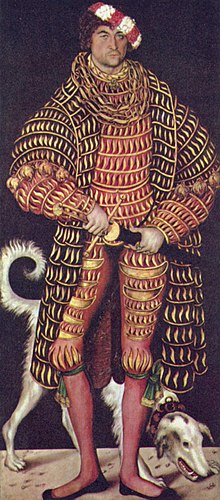



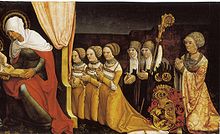
Sophia of Brunswick-Lüneburg (1358–28 May 1416), daughter of Magnus II, Duke of Brunswick-Lüneburg
Frederick I, the Belligerent or the Warlike (German: Friedrich der Streitbare; 11 April 1370 – 4 January 1428), a member of theHouse of Wettin, ruled as Margrave of Meissen from 1407 and Elector of Saxony (as Frederick I) from 1423 until his death.
He is not to be confused with his cousin Landgrave Frederick IV of Thuringia, the son of Landgrave Balthasar.
He was the eldest son of Frederick III, Landgrave of Thuringia, and Catherine of Henneberg. After the death of his uncle William I, Margrave of Meissen in 1407, he governed the Margraviate of Meissen together with his brother William II as well as with his cousinFrederick IV (son of Balthasar), until their possessions were divided in 1410 and 1415.

Catherine of Brunswick-Lüneburg (1395 – 28 December 1442, Grimma) was a member of the House of Welf, a princess ofBrunswick-Lüneburg and by marriage, the Electress of Saxony.
Catherine was the only daughter and second child of the Duke Henry I of Brunswick-Lüneburg († 1416) from his first marriage to Sophie († June 1400), daughter of Duke Wartislaw VI of Pomerania.
William (German: Wilhelm) KG (c. 1392 – 1482), called the Victorious, was duke of Brunswick-Lüneburg. He is counted either asWilliam III or William IV.
William was the eldest son of Henry the Mild, Duke of Brunswick-Lüneburg. He inherited Lüneburg-Celle in 1416 and swapped it with his uncle Bernard I, Duke of Brunswick-Lüneburg, for Wolfenbüttel in 1428. While on a campaign in 1432, William was deposed by his brother Henry. William retained only the western part of Wolfenbüttel (to the west of the River Leine and separated from the rest by the Bishopric of Hildesheim), which was to become known as the Principality of Calenberg. After Henry died without son in 1473, William had control of both parts of Wolfenbüttel again.
Cecilia of Brandenburg (c. 1405 – 4 January 1449) was a princess of Brandenburg by birth and by marriage a Duchess ofBrunswick-Wolfenbüttel.
Cecilia was the daughter of Elector Frederick I of Brandenburg (1371–1440) from his marriage to Elizabeth (1383–1442), daughter of Duke Frederick of Bavaria-Landshut. Cecilia's brothers were the reigning Electors of Brandenburg, first Frederick II and later Albrecht III Achilles.
Count Bodo VII of Stolberg and Wernigerode (also known as Bodo the Elder; born: 1375; died: 15 March 1455 in Stolberg) was a German nobleman. He ruled the counties of Stolberg in the southern Harz and Wernigerode in the northern Harz.
Bodo was the son of Count Henry of Stolberg and Elizabeth née Countess of Hohenstein. Nothing is known about his youth. Perhaps he spent some time at a court of the Counts of Schwarzburg, possibly the one in the Sondershausen.
Anna, the daughter of Count Henry of Schwarzburg,
Duke Wartislaw IX of Pomerania-Wolgast (c. 1400 – 17 April 1457, Wolgast) was the eldest son of the Duke Barnim VI, Duke of Pomerania and Veronica. Europaische Stammtafaln does not cite an origin for Veronica.[1]

Bogusław IX; (1407/1410 – 7 December 1446) was a duke of Pomerania in Pomerania-Stolp, whose residence was Stargard. His cousin Eric of Pomerania tried in vain to have him recognized as King of the Kalmar Union.
Bogusław was the son of Bogislaw VIII, Duke of Pomerania, and Sophia of Holstein. On June 24, 1432 in Poznan he married Maria of Masovia, daughter of Siemowit IV, Duke of Masovia and Alexandra of Lithuania.[1] They had daughters, Sophia, who marriedEric II, Duke of Pomerania, and Alexandra, and at least one of unknown name.[2]
Maria of Masovia (pl: Maria mazowiecka; 1408/15 - 14 February 1454), was a Polish princess member of the House of Piast in the Masovian branch.
She was the sixth daughter of Siemowit IV, Duke of Masovia and Alexandra, a daughter of Algirdas, Grand Duke of Lithuania and sister of King Władysław II Jagiełło of Poland.
Federico III del Palatinado, el Piadoso (Simmern, Alemania, 14 de febrero de 1515 - Heidelberg, Alemania, 24 o 26 de octubre de 1576), procedía de la Casa de Wittelsbach y fue Conde Palatino de Simmern-Sponheim y Príncipe elector del Palatinado(1559-1576). Sus padres eran el Conde palatino Juan II (1492-1557) y Beatriz de Baden (1492- 1535).

María, hija del margrave Casimiro de Brandeburgo-Kulmbach y su esposa Susana, hija del duque bávaro Alberto IV
Count Wolrad I of Waldeck (c. 1399 – after 1 February 1475) was a son of Count Henry VII of Waldeck and his wife Margaret of Nassau-Wiesbaden-Idstein. He was named after his maternal grandfather, and was to first Wolrad in the House of Waldeck. He succeeded his father as the reigning Count of Waldeck-Waldeck in 1442 – whether this was before or after his father's death is still unclear. The House Waldeck had been split since 1397 into the senior Waldeck-Landau line and the junior Waldeck-Waldeck line.
Barbara of Wertheim, a daughter of Count Michael I of Wertheim
Count Jan (Johann) IV of Nassau (1 August 1410, Dillenburg – 3 February 1475, Breda) was Count of Nassau, Dietz and Dillenburg. He was the son of Engelbert I of Nassau, Count of Nassau and Dillenburg, Lord of Breda and Johanna van Polanen. [
Maria of Loon-Heinsberg (1426 – 20 April 1502) was the daughter of John I, Count Loon-Heinsberg. Her mother was Countess Margaret of Solms-Braunfels.
Maria died on 20 April 1502 and is buried with her husband in the mausoleum of Engelbert I of Nassau in the Church of Our Ladyat the Market Square in Breda.
Enrique V de Sajonia-Meissen, apodado el Piadoso (en alemán, Heinrich der Fromme; Meißen, 1473 - ibídem, 1541), fue un duque de Sajonia (1539-1541), proveniente de la casa de Wettin.
Era hijo de Alberto III de Sajonia-Meissen y Sidonia de Bohemia. Sucedió a su hermano Jorge el Barbudo cuando tenía 66 años. A diferencia de su muy católico hermano, Enrique se convirtió al Luteranismo en 1536 por mediación de su esposa Catalina deMecklemburgo. Hizo que la confesión protestante fuera la oficial en el Ducado de Sajonia. Todos sus súbditos debían adoptarla también so pena de ser encarcelados o exiliados del país.

Joaquín II Héctor (en alemán Joachim II. Hector o Hektor) (13 de enero de 1505 - 3 de febrero de 1571), miembro de la Casa de Hohenzollern, fue el príncipe-elector del Margrave de Brandeburgo entre 1535 y 1571. Joaquín II fue hijo de Joaquín I Néstor, elector de Brandenburgo, y de su esposa Isabel de Dinamarca, Noruega y Suecia hija de Juan I de Dinamarca. Su apodo Héctor deriva del príncipe troyano Héctor, de la mitología griega. Fue padre de Juan Jorge de Brandeburgo.


Fedor Andreevich Kobylin, byname "Koshka" ("the Cat") (Russian: Фёдор Андре́евич Кобылин (Ко́шка)) (? – 1407), was the youngest son of Andrei Ivanovich Kobyla and progenitor of the Romanov dynasty and Sheremetev family.
He was a senior boyar in the Duma of Dmitri Donskoi and his son Vasili I of Russia. According to some sources, Koshka governed Moscow during Dmitry's absence in the Battle of Kulikovo. In 1393, he was recorded as negotiating with Novgorod for peace.
His cautionary approach towards the Tatars was praised by Edigu in his 1407 letter to Vasili I. It is believed that Fyodor died about that date. His daughters Anna and Akulina married a Prince of Rostov and Prince of Mikulin, while his granddaughter Maria married Yaroslav of Borovsk, father-in-law of Vasili II of Russia. He had three sons: Ivan Fyodorovich Koshkin, Fedor Fedorovich Koshkin, and Alexander Fyodorovich Koshkin.
Christoph I of Baden (13 November 1453 – 19 April 1527) was the Margrave of Baden from 1475 to 1515.
Christoph was the eldest son of Karl I, Margrave of Baden-Baden and Catherine of Austria, a sister of Frederick III, Holy Roman Emperor. He built the New Castle and moved there in 1479. In 1515 he divided his possessions between his sons Bernhard, Philipp and Ernst. Thus, Bernhard founded the so-called "Bernardine line" of Baden-Baden and Ernst founded the "Ernestine line" of Baden-Durlach.

Ottilie of Katzenelnbogen (ca. 1451[1] – 15 August 1517, Baden-Baden), was by marriage Margravine of Baden-Baden.
She was the only child of Philipp II the Younger of Katzenelnbogen (1427 – 27 February 1453) and Ottilie of Nassau-Dillenburg (April 1437 – July 1493). Her baptism took place one month after her father's death, on 22 March in Starkenburg Castle, nearDarmstadt.

Alexander of Zweibrücken (German: Pfalzgraf Alexander von Zweibrücken "der Hinkende") (26 November 1462 – 21 October 1514) was Count Palatine and Duke of Zweibrücken and of Veldenz in 1489–1514.
He was the son of Louis I, Count Palatine of Zweibrücken and his wife Johanna of Croÿ. Alexander promised to establish a church after the successful return from a crusade, and it was kept in 1489 with the building of the Alexanderskirche in Zweibrücken.
Countess Margarete of Hohenlohe-Neuenstein, daughter of Count Kraft VI of Hohenlohe and Helene of Württemberg.
No hay comentarios:
Publicar un comentario